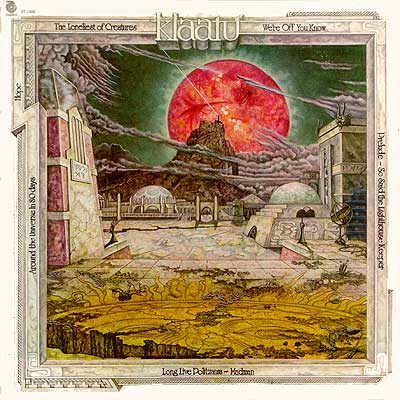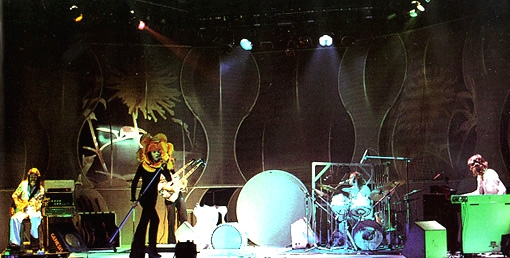/PAlogo_v2.gif)
/PAlogo_v2.gif) |
|
Post Reply 
|
| Author | |
Certif1ed 
Special Collaborator 

Honorary Collaborator Joined: April 08 2004 Location: England Status: Offline Points: 7559 |
 Topic: Understanding Art Rock Topic: Understanding Art RockPosted: May 10 2005 at 03:35 |
|
Good article, Maani - but I would correct "the first was Marillion..." to "the first was Twelfth Night", since "Live At the Target" predates "Script..." by 3 years, and the material leading up to "Fact and Fiction" was written during those 3 years - while (Sil)Marillion were still forming as a band. Marillion were the most prominent, but not first. ...not that it's particularly important... |
|
 |
|
maani 
Special Collaborator 

Founding Moderator Joined: January 30 2004 Location: United States Status: Offline Points: 2632 |
 Posted: May 09 2005 at 19:43 Posted: May 09 2005 at 19:43 |
|
Just found the following, which coincides with ivan's and seyo's comments: "Progressive rock and art rock are two almost interchangeable terms describing a mostly British attempt to elevate rock music to new levels of artistic credibility. The differences between prog-rock and art rock are often slight in practice, but do exist. Prog-rock tends to be more traditionally melodic (even when multi-sectioned compositions replace normal song structures), more literary (poetry or sci-fi/fantasy novels), and more oriented toward classically trained instrumental technique (with the exception of Pink Floyd). Art rock is more likely to have experimental or avant-garde influences, placing novel sonic texture above prog-rock's symphonic ambitions. Both styles are intrinsically album-based, taking advantage of the format's capacity for longer, more complex compositions and extended instrumental explorations. In fact, many prog bands were fond of crafting concept albums that made unified statements, usually telling an epic story or tackling a grand overarching theme. In addition to pushing rock's technical and compositional boundaries, prog-rock was also arguably the first arena where synthesizers and electronic textures became indispensable parts of a rock ensemble. The earliest rumblings of progressive and art rock could be heard in the poetry of Bob Dylan and conceptually unified albums like the Mothers of Invention's Freak Out! and the Beatles' Sgt. Pepper's Lonely Hearts Club Band, all of which suggested that rock was more than just teenagers' music and should be taken seriously as an art form. Prog-rock began to emerge out of the British psychedelic scene in 1967, specifically a strain of classical/symphonic rock led by the Nice, Procol Harum, and the Moody Blues (Days of Future Passed). King Crimson's 1969 debut In the Court of the Crimson King firmly established the concept of progressive rock, and a quirky, eclectic scene was taking shape in Canterbury, led by the jazzy psychedelia of the Soft Machine. Prog-rock became a commercial force in the early '70s, with Emerson, Lake & Palmer, Yes, Jethro Tull, Genesis, and Pink Floyd leading the way. Meanwhile, a more avant-garde scene (dubbed Kraut-rock) was developing in Germany, and eccentric, unclassifiable bands continued to emerge in the U.K. By the mid-'70s, a backlash was beginning to set in; prog-rock sometimes mistook bombast for majesty, and its far-reaching ambition and concern with artistic legitimacy could make for overblown, pretentious music. Its heyday soon came to an end with the advent of punk, which explicitly repudiated prog's excesses and aimed to return rock & roll to its immediate, visceral roots. Still, prog-rock didn't completely go away. A number of AOR bands used prog ideas in more concise songs; plus, Pink Floyd, Yes, and Genesis all had number one singles in the '80s by retooling their approaches. A small cult of neo-prog bands catered to faithful audiences who still liked grandiose concepts and flashy technique; the first was Marillion, and many more popped up in the late '80s and early '90s." |
|
 |
|
Seyo 
Special Collaborator 
Honorary Collaborator Joined: May 08 2004 Location: Bosnia Status: Offline Points: 1320 |
 Posted: May 09 2005 at 16:14 Posted: May 09 2005 at 16:14 |
|
"The differences between prog-rock and art rock are often slight in practice, but do exist. Prog-rock tends to be more traditionally melodic (even when multi-sectioned compositions replace normal song structures), more literary (poetry or sci-fi/fantasy novels), and more oriented toward classically trained instrumental technique (with the exception of Pink Floyd). Art rock is more likely to have experimental or avant-garde influences, placing novel sonic texture above prog-rock's symphonic ambitions."
So says allmusic.com 
For many years I considered Bowie, Roxy Music, Eno, Fripp, Gabriel, David Byrne (Talking Heads), Japan, David Sylvian etc.. to be "art-rock". You can find some common aestetics in the works of all of those, but nothing important really. You can call it whatever you want. All the genre classifications were after all imagination of the press and media people. |
|
 |
|
Certif1ed 
Special Collaborator 

Honorary Collaborator Joined: April 08 2004 Location: England Status: Offline Points: 7559 |
 Posted: May 09 2005 at 03:02 Posted: May 09 2005 at 03:02 |
|
Art rock is a silly term - a dumping ground for anything that doesn't quite fit anywhere else. Don't use it |
|
 |
|
Ivan_Melgar_M 
Special Collaborator 
Honorary Collaborator Joined: April 27 2004 Location: Peru Status: Offline Points: 19557 |
 Posted: May 09 2005 at 02:25 Posted: May 09 2005 at 02:25 |
|
Art Rock is a confusing term because it had several meanings through the years: When Prog' was young, Art Rock was a synonym for Progressive Rock, both terms were used to describe the same genre. Art Rock now is described as the simpler form of prog', exactly the limit that divides progressive rock from POP or mainstream, I agree with this definition and bands as Asia, Styx, ELO, Roxy Music or even Queen may be included in this genre. As Gdub said, Art Rock is wrongly used as a what we call in Perú "a Tailor box" (The tailors usually have a box where they keep the small pieces of fabric that are left after making of a suit, this pieces of fabric are from several colors and sizes), so the bands that are more complex or ambitious than common mainstream but nobody knows how to catalogue are lumped there, despite their style, sound or influence. About Peter Gabriel, I don't think he's part of Art Rock, because I'm not sure if he's even prog', maybe experimental but he's very close to World Music, despite the genre, his work is amazing. Iván Edited by ivan_2068 |
|

|
|
 |
|
Garion81 
Special Collaborator 
Honorary Collaborator Joined: May 22 2004 Location: So Cal, USA Status: Offline Points: 4338 |
 Posted: May 09 2005 at 01:38 Posted: May 09 2005 at 01:38 |
|
I think James Lee hit in on the head with his post.
 I also might include a band Like Queen. I have argued with Maani about Kansas being Art Rock under the definiton of the webmasters here. I think they were symphonic rock even if their songs were simple at times. But with the advent of songs like Song for America and the Pinnacle to name a couple there was no doubt they were as good as anything I had heard out of England. I also might include a band Like Queen. I have argued with Maani about Kansas being Art Rock under the definiton of the webmasters here. I think they were symphonic rock even if their songs were simple at times. But with the advent of songs like Song for America and the Pinnacle to name a couple there was no doubt they were as good as anything I had heard out of England.
|
|

"What are you going to do when that damn thing rusts?" |
|
 |
|
Aaron 
Forum Senior Member 
Joined: April 08 2004 Location: United States Status: Offline Points: 395 |
 Posted: May 08 2005 at 17:45 Posted: May 08 2005 at 17:45 |
|
I dont like how Transatlantic is defined as art rock by this site i define art rock as pop prog basically, maybe like pop inspired by prog or something Aaron |
|
 |
|
chant 
Forum Newbie 
Joined: May 08 2005 Status: Offline Points: 4 |
 Posted: May 08 2005 at 10:13 Posted: May 08 2005 at 10:13 |
|
Art Rock as I understood it in my youth was the name of prog, since in the mid-70's in Canada , there was ony that name for it! Yes, Genesis , ELP,Supertramp etc... were Art-rock bands; This might have slipped a bit towards Glam rock for people wanting to include Roxy Music and Queen in it! Edited by chant |
|
 |
|
gdub411 
Forum Senior Member 

Joined: August 24 2004 Location: United States Status: Offline Points: 3484 |
 Posted: May 08 2005 at 09:39 Posted: May 08 2005 at 09:39 |
|
I always thought it was more of a catch all term. When a band's style couldn't fit into any of the other sub-genres, it would be lumped into the 'generic' definition of "art-rock"
|
|
 |
|
Rob The Good 
Forum Senior Member 
Joined: December 17 2004 Location: New Zealand Status: Offline Points: 476 |
 Posted: May 08 2005 at 05:46 Posted: May 08 2005 at 05:46 |
|
It's popular music with a difference - it extends the boundaries that people normally associate with pop. Roxy Music, David Bowie... Experimental pop if you will. |
|
|
And Jesus said unto John, "come forth and receive eternal life..."
Unfortunately, John came fifth and was stuck with a toaster. |
|
 |
|
James Lee 
Special Collaborator 
Honorary Collaborator Joined: June 05 2004 Status: Offline Points: 3525 |
 Posted: May 07 2005 at 19:51 Posted: May 07 2005 at 19:51 |
|
I think art rock must be one of those genres that everybody defines a bit differently...the site definition is fairly inclusive (it's probably vague on purpose) but the examples don't fit my idea of 'art rock' (except for Peter Gabriel). For me, art rock has more of an experimental, even pretentious (in the best possible sense of the word) influence...Gabriel and Reed and Bowie and Eno type of thing. Pop music with artistic approach. Kate Bush, definitely. As opposed to symphonic, which to me is rock with orchestral elements in the instruments and sometimes in the structure as well. From the Beatles to ELO, but more 'prog' examples would be a number of the Italian bands ("Appena un Poco" is my perfect example) and Kansas, and Floyd at times (things like "Atom Heart Mother", especially). |
|
 |
|
Sweetnighter 
Forum Senior Member 
Joined: October 24 2004 Location: United States Status: Offline Points: 1298 |
 Posted: May 07 2005 at 18:52 Posted: May 07 2005 at 18:52 |
|
So how do you define art rock, and what are its boundaries? I've always
understood art rock to be a sort of sissy prog rock, in a way... groups
that aren't entirely prog and were big arena acts at one point.
Examples of this include Supertramp, Styx, and Asia. Now, would you
consider groups like Boston or Journey to be art rock, or not? And when
is a band no longer "art rock" but symphonic or or something else?
|
|
|
I bleed coffee. When I don't drink coffee, my veins run dry, and I shrivel up and die.
"Banco Del Mutuo Soccorso? Is that like the bank of Italian soccer death or something?" -my girlfriend |
|
 |
|
Post Reply 
|
|
| Forum Jump | Forum Permissions  You cannot post new topics in this forum You cannot reply to topics in this forum You cannot delete your posts in this forum You cannot edit your posts in this forum You cannot create polls in this forum You cannot vote in polls in this forum |